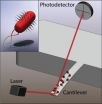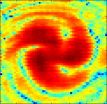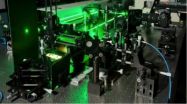(Press-News.org) San Francisco, September 15, 2014—Mobility is equally preserved in cancer patients suffering from malignant spinal cord compression (MSCC) who receive a single dose of 10 Gy of radiation therapy (RT), compared to patients who receive five daily doses of 4 Gy of RT each, according to research presented today at the American Society for Radiation Oncology's (ASTRO's) 56th Annual Meeting.
Malignant spinal cord compression (MSCC) is a complication of metastatic cancer mostly with bone involvement that occurs when a tumor's secondary deposit presses on the spinal cord and nerves. This pressure exposes patients to neurological damage that can result in pain, loss of muscle strength and function of one or more of the senses. In some cases, the neurological damage can lead to paralysis of the entire body below the neck or paralysis of one or more limbs.
Although the standard of care for patients with MSCC is a combination of direct decompressive surgery and radiation therapy, sometimes surgery is not an option and patients receive only therapeutic radiation therapy. Currently, there is not a defined, optimal radiation therapy technique, or dose and schedule for patients with MSCC who do not undergo surgery.
This ICORG (All Ireland Co-operative Oncology Research Group) prospective, randomized, non-inferiority, Phase III trial compared two radiation therapy fractionation schedules in patients with MSCC who had not undergone surgery. From 2006 to 2014, five centers in Ireland and the United Kingdom accrued 116 patients with pathologically proven metastatic cancer. The study included 42 women and 74 men, with a median age of 69. The patients' median Karnofsky performance status (KPS) score was 60 out of a possible 100. (KPS is a standard scale used to assess patients' ability to perform ordinary tasks).
The patients' main primary tumor sites (initial locations of the patients' cancer) were 24 percent prostate cancer (28 patients); 20 percent breast cancer (23 patients); and 19 percent lung cancer (22 patients).
The patients' MSCC sites included 4.3 percent cervical (five patients); 67 percent thoracic (78 patients); 23.5 percent lumbar (27 patients); 2.6 percent sacral (three patients) and 2.6 percent two synchronous occurring in more than one area at the same time (three patients).
Patients were randomized into two groups, with baseline characteristics balanced between both groups. Group One (the control group) received 20 Gy of EBRT, delivered over five treatment days. Group Two received an experimental high-dose of 10 Gy of EBRT, delivered in one single treatment.
The study measured the change in the patients' mobility at five weeks based on a modified Tomita scoring system. The modified Tomita score evaluated patient mobility using a three-class scale, with class I indicating the patient was mobile and unaided; class II indicating the patient was mobile with a walking aid; and Class III indicating the patient was bed-bound (which corresponds to the original Tomita scale class III and IV).
The study also evaluated patients' changes in bladder function at five weeks, using an in-house scoring scale, acute and long-term side effects (based on the Radiation Therapy Oncology Group, or RTOG scale) and overall survival (OS).
At five weeks post-treatment, 76 patients—38 patients in Group One and 38 patients in Group Two were evaluable. Analysis of the evaluable patients showed no statistically significant difference in overall mobility score change at five weeks post-treatment, with an overall response (improvement/stability) rate of 68.4 percent (10.5 improvement/57.9 percent stability) for Group One; and 78.9 percent (10.5 percent improvement/68.4 percent stability) for Group Two. Additionally, there wasn't a significant difference in mean mobility score changes, with a difference of -0.29 for Group One and a difference of -0.08 for Group Two (difference = -0.21, 95%CI: -0.56 to 0.14, +0.4 non-inferiority margin outside 95%CI), confirming the non-inferiority statistical hypothesis.
No significant differences were also detected in patients' bladder function score changes at five weeks post-treatment, with an overall response (improvement/stability) rate of 75.7 percent (10.8 percent improvement/ 64.9 stability) for Group One; and 86.8 percent (2.6 percent improvement/84 percent) for Group Two. The groups' mean sphincter score changes were -0.22 for Group One and -0.16 for Group Two (difference = -0.06, 95%CI: -0.44 to 0.32).
The neurological deterioration-free survival and overall survival median durations were similar in both groups, with a median neurological deterioration free survival time of 1.4 months and a median overall survival time of four months
Additionally, the reported overall toxicity (side effect rate) for the entire group of patients was low; there was one, Grade 3 acute side effect reported and two Grade 3 long-term side effects reported.
"Our study shows that while radiotherapy alone provides only short-term neurological stabilization, the single treatment, high-dose experimental treatment was as effective as the current standard of care," said lead author Pierre Thirion, MD, consultant radiation oncologist a at St. Luke's Radiation Oncology Network in Dublin, Ireland. "Sometimes less treatment is as effective, and our research can help reduce the burden of treatment and frequency of hospital visits for this patient population, while maintaining the same clinical outcome and quality of care, as well as the treatment cost. The study also highlights the poor overall outcome for MSCC patients, both in terms of daily living and overall survival, since less than half of these patients survived four months. These findings confirm the importance of further clinical research to improve patient outcome and the essential role of cooperative clinical research group, such as ICORG, to lead it."
INFORMATION:
The abstract, "ICORG 05-03: Prospective Randomised Non-Inferiority Phase 3 Trial Comparing Two Radiation Schedules in Malignant Spinal Cord Compression not Proceeding with Surgical Decompression," will be presented in detail during the plenary session at ASTRO's 56th Annual Meeting at 2:15 p.m., Pacific time on Monday, September 15, 2014. To speak with Dr. Thirion, please call Michelle Kirkwood on September 14 – 17, 2014, in the ASTRO Press Office at the Moscone Center in San Francisco Center at 415-978-3503 or 415-978-3504, or email michellek@astro.org.
ASTRO's 56th Annual Meeting, to be held at the Moscone Center in San Francisco, September 14-17, 2014, is the nation's premier scientific meeting in radiation oncology. The 2014 Annual Meeting is expected to attract more than 11,000 attendees including oncologists from all disciplines, medical physicists, dosimetrists, radiation therapists, radiation oncology nurses and nurse practitioners, biologists, physician assistants, practice administrators, industry representatives and other health care professionals from around the world. Led by ASTRO President Bruce G. Haffty, MD, FASTRO, a radiation oncologist specializing in breast cancer, the theme of the 2014 Meeting is "Targeting Cancer: Technology and Biology," and the Presidential Symposium, "Local-regional Management of Breast Cancer: A Changing Paradigm," will feature Jay R. Harris, MD, FASTRO, and Thomas A. Buchholz, MD, FASTRO, to highlight recent practice-changing, landmark studies and current developments in the local-regional management of breast cancer. ASTRO's four-day scientific meeting includes presentation of up to four plenary papers, 360 oral presentations, 1,862 posters and 144 digital posters in more than 50 educational sessions and scientific panels for 20 disease-site tracks. Three keynote speakers will address a range of topics including oncologic imaging, biology and targeting in oncology, and human error and safety concerns: Hedvig Hricak, MD, PhD, Chair of the Department of Radiology and the Carroll and Milton Petrie Chair at Memorial Sloan Kettering Cancer Center; Frank McCormick, PhD, FRS, DSc (hon), Professor Emeritus and the David A. Wood Distinguished Professor of Tumor Biology and Cancer Research of the University of California at San Francisco Helen Diller Family Comprehensive Cancer Center; and Sidney Dekker, PhD, MA, MSc, Professor and Director of the Safety Science Innovation Lab at Griffith University, Brisbane, Australia.
About ASTRO
ASTRO is the premier radiation oncology society in the world, with more than 10,000 members who are physicians, nurses, biologists, physicists, radiation therapists, dosimetrists and other health care professionals that specialize in treating patients with radiation therapies. As the leading organization in radiation oncology, the Society is dedicated to improving patient care through professional education and training, support for clinical practice and health policy standards, advancement of science and research, and advocacy. ASTRO publishes two medical journals, International Journal of Radiation Oncology • Biology • Physics and Practical Radiation Oncology; developed and maintains an extensive patient website, http://www.rtanswers.org; and created the Radiation Oncology Institute, a non-profit foundation to support research and education efforts around the world that enhance and confirm the critical role of radiation therapy in improving cancer treatment. To learn more about ASTRO, visit http://www.astro.org.
2014 American Society for Radiation Oncology (ASTRO) 56th Annual Meeting
News Briefing, Monday, September 15, 2014, 11:00 a.m., Pacific time
Scientific Session: Monday, September 15, 2014, 2:15 – 3:25 p.m., PT, the Moscone Center
LBA2 ICORG 05-03: Prospective Randomised Non-Inferiority Phase 3 Trial Comparing Two Radiation Schedules in Malignant Spinal Cord Compression not Proceeding with Surgical Decompression
Author Block: P. Thirion1,2, L. O'Sullivan*1,2, A. Clayton-Lea*1,2, C. Small*1,3, O. McArdle*1,2, P. Kelly*1,4, I. Parker*1, J. O'Sullivan*1,5, D. Hacking*1,6, C. Collins*2, M. Pomeroy*1,3, M. Moriarty*1,2. , 1All Ireland Cooperative Oncology Research Group, Dublin, Ireland, 2St Luke's Radiation Oncology Network, Dublin, Ireland, 3Galway University Hospital, Galway, Ireland, 4Cork University Hospital, Cork, Ireland, 5Belfast City Hospital, Belfast, United Kingdom, 6Whitfield Clinic, Waterford, Ireland,
Purpose / Objective(s): To prospectively compare two External Beam Radiation Therapy (EBRT) Fractionation Schedules (FS) in patients (pts) with Malignant Spinal Cord Compression (MSCC) not proceeding with surgical decompression.
Materials / Methods: An ICH-GCP compliant prospective (1.1) randomised non-inferiority phase 3 trial compared two EBRT-FS: arm 1 (control): 20 Gy / 5 fractions (#) vs. arm 2 (experimental): 10 Gy / 1 #, with 90% power, 5% significant level and +0.4 non-inferiority margin. The primary end-point was the change in mobility at 5 weeks (Modified Tomita score); the secondary end-points were change in bladder function at 5 weeks (in-house score), acute and long-term toxicity (RTOG scale), and overall survival (OS). Eligible pts had pathologically proven metastatic cancer, excluding haematological/ germ cell malignancies, and diagnosed with a MRI documented treatment naïve symptomatic MSCC.
Results: From 2006 to 2014, 5 institutions accrued 116 pts (1 non-eligible pt, no treatment allocation violation), 76 pts alive at 5 weeks were evaluable. The baseline characteristics were balanced between arms [♀/♂ ratio: 36/64, median age: 69 (range: 30-87), median baseline KPS: 60 (range: 30 - 100)]. The main primary tumour sites were prostate (24%), breast (20%) and lung (19%). The MSCC sites were cervical (4.3%), thoracic (67%), lumbar (23.5%), sacral (2.6%) and two synchronous levels (2.6%, 3 pts treated with same FS). Analysis of evaluable pts showed no statistically significant differences in 1) overall mobility score change at 5 week [Overall response (Improvement/Stability) rate: arm 1: 68.4% (10.5/57.9) vs. arm 2: 78.9% (10.5/68.4); mean mobility score change: arm 1: -0.29 vs. arm 2: -0.08, difference= -0.21, 95%CI: -0.56 to 0.14, +0.4 non-inferiority margin outside 95%CI] or 2) bladder function score change at 5 weeks [Overall response (Improvement/stability) rate: arm 1: 75.7% (10.8/ 64.9) vs. arm 2: 86.8% (2.6/84.); mean sphincter score change: arm 1: -0.22 vs arm 2: -0.16, difference = -0.06, 95%CI: -0.44 to 0.32]. The mobility deterioration free survival and overall survival median durations were similar in both arms respectively 1.4 months and 4 months. Independent favourable prognostic factors were 1) for 5 week mobility overall response: preserved baseline mobility, and 2) for OS: preserved baseline mobility, high baseline KPS, young age and non-lung primary. The reported overall toxicity was low with 1 G3-acute and 1 G3-long-term toxicity events (arm 2) and no higher grade toxicity reported.
Conclusions: With respect to mobility preservation, 10 Gy / 1 # is at least equivalent to 20 Gy / 5#. When using EBRT in similar pts, a single fraction schedule should be considered.
Author Disclosure Block: P. Thirion: None. L. O'Sullivan: None. A. Clayton-Lea: None. C. Small: None. O. McArdle: None. P. Kelly: None. I. Parker: None. J. O'Sullivan: None. D. Hacking: None. C. Collins: None. M. Pomeroy: None. M. Moriarty: None.
Cancer patients with malignant spinal cord compression have preserved mobility
When administered one high-dose of radiation therapy compared to more frequent lower doses of radiation therapy
2014-09-16
ELSE PRESS RELEASES FROM THIS DATE:
And so they beat on, flagella against the cantilever
2014-09-16
WASHINGTON D.C., September 16, 2014 – A team of researchers at Boston University and Stanford University School of Medicine has developed a new model to study the motion patterns of bacteria in real time and to determine how these motions relate to communication within a bacterial colony.
The researchers chemically attached colonies of Escherichia coli bacteria to a microcantilever – a microscopic beam anchored at one end, similar to a diving board – thus coupling its motion to that of the bacteria. As the cantilever itself isn't doesn't generate any vibrations, or 'noise,' ...
NASA sees Tropical Storm Odile knocking at US Southwest
2014-09-16
Tropical Storm Odile continues to drench western Mexico and has now entered into the U.S. Southwest. On September 15, NASA's Terra satellite saw Odile's northernmost edge crossing the Mexican border into southern California. NOAA's GOES-East satellite on September 16 showed Odile's outer bands were already bringing storms to southern Arizona.
NASA Sees Odile Knocking on U.S. Border
On Sept. 15 at 2:35 p.m. EDT, the Moderate Resolution Imaging Spectroradiometer instrument aboard NASA's Terra satellite saw the northern fringes of Hurricane Odile straddling the border ...
Scientists twist radio beams to send data
2014-09-16
Building on previous research that twisted light to send data at unheard-of speeds, scientists at USC have developed a similar technique with radiowaves, reaching high speeds without some of the hassles that can go with optical systems.
The researchers, led by electrical engineering professor Alan Willner of the USC Viterbi School of Engineering, reached data transmission rates of 32 gigabits per second across 2.5 meters of free space in a basement lab at USC.
For reference, 32 gigabits per second is fast enough to transmit more than 10 hour-and-a-half-long HD movies ...
Kessler Foundation scientists link slowed processing speed with executive deficits in MS
2014-09-16
West Orange, NJ. September 16, 2014. Kessler Foundation researchers have published a study supporting the role of slowed processing speed in the executive deficits found in individuals with multiple sclerosis (MS). "Does slowed processing speed account for executive deficits in multiple sclerosis? Evidence from neuropsychological performance and structural neuroimaging," was published online ahead of print on August 18 by Rehabilitation Psychology The authors are Victoria Leavitt, PhD, of the Manhattan Memory Center, formerly of Kessler Foundation. Co-authors are Foundation ...
Tornadoes occurring earlier in 'Tornado Alley'
2014-09-16
WASHINGTON, D.C. – Peak tornado activity in the central and southern Great Plains of the United States is occurring up to two weeks earlier than it did half a century ago, according to a new study whose findings could help states in "Tornado Alley" better prepare for these violent storms.
Tornado records from Nebraska, Kansas, Oklahoma, and northern Texas – an area of high tornado activity dubbed "Tornado Alley" -- show that peak tornado activity is starting and ending earlier than it did 60 years ago.
Peak tornado activity, which occurs in the region from early ...
Water-based nuclear battery developed by MU can be used to generate electrical energy
2014-09-16
COLUMBIA, Mo. – From cell phones to cars and flashlights, batteries play an important role in everyday life. Scientists and technology companies constantly are seeking ways to improve battery life and efficiency. Now, for the first time using a water-based solution, researchers at the University of Missouri have created a long-lasting and more efficient nuclear battery that could be used for many applications such as a reliable energy source in automobiles and also in complicated applications such as space flight.
"Betavoltaics, a battery technology that generates power ...
Patients waiting too long to see doctor? Try 'just-in-time' management methods, researchers urge
2014-09-16
Using a pain clinic as a testing ground, researchers at Johns Hopkins have shown that a management process first popularized by Toyota in Japan can substantially reduce patient wait times and possibly improve the teaching of interns and residents.
In a report on the pilot study, published online Sept. 9, in Pain Medicine, the researchers adopted the so-called "Just-in-Time" training and inventory process used now by many manufacturers and service industries to stem waste and keep complicated operations from bottlenecking.
"We realized that a significant amount of time ...
Study on global carbon cycle may require reappraisal of climate events in Earth's history
2014-09-16
MIAMI – A recent study of the global carbon cycle offers a new perspective of Earth's climate records through time. Scientists at the University of Miami (UM) Rosenstiel School of Marine and Atmospheric Science suggest that one of the current methods for interpreting ancient changes in the concentration of carbon dioxide in the atmosphere and oceans may need to be re-evaluated.
The UM Rosenstiel School researchers measured the abundance of carbon-12 and carbon-13 isotopes in both the organic matter and carbonate sediments found in a nearly 700-meter marine sediment core ...
UCI team is first to capture motion of single molecule in real time
2014-09-16
Irvine, Calif., Sept. 16, 2014 – UC Irvine chemists have scored a scientific first: capturing moving images of a single molecule as it vibrates, or "breathes," and shifts from one quantum state to another.
The groundbreaking achievement, led by Ara Apkarian, professor of chemistry, and Eric Potma, associate professor of chemistry, opens a window into the strange realm of quantum mechanics – where nanoscopic bits of matter seemingly defy the logic of classical physics.
This could lead to a wide variety of important applications, including lightning-fast quantum computers ...
Making quantum dots glow brighter
2014-09-16
WASHINGTON, D.C., September 16, 2014 – Researchers from the University of Alabama in Huntsville and the University of Oklahoma have found a new way to control the properties of quantum dots, those tiny chunks of semiconductor material that glow different colors depending on their size. Quantum dots, which are so small they start to exhibit atom-like quantum properties, have a wide range of potential applications, from sensors, light-emitting diodes, and solar cells, to fluorescent tags for biomedical imaging and qubits in quantum computing.
A key property of quantum ...
LAST 30 PRESS RELEASES:
Making lighter work of calculating fluid and heat flow
Normalizing blood sugar can halve heart attack risk
Lowering blood sugar cuts heart attack risk in people with prediabetes
Study links genetic variants to risk of blinding eye disease in premature infants
Non-opioid ‘pain sponge’ therapy halts cartilage degeneration and relieves chronic pain
AI can pick up cultural values by mimicking how kids learn
China’s ecological redlines offer fast track to 30 x 30 global conservation goal
Invisible indoor threats: emerging household contaminants and their growing risks to human health
Adding antibody treatment to chemo boosts outcomes for children with rare cancer
Germline pathogenic variants among women without a history of breast cancer
Tanning beds triple melanoma risk, potentially causing broad DNA damage
Unique bond identified as key to viral infection speed
Indoor tanning makes youthful skin much older on a genetic level
Mouse model sheds new light on the causes and potential solutions to human GI problems linked to muscular dystrophy
The Journal of Nuclear Medicine ahead-of-print tip sheet: December 12, 2025
Smarter tools for peering into the microscopic world
Applications open for funding to conduct research in the Kinsey Institute archives
Global measure underestimates the severity of food insecurity
Child survivors of critical illness are missing out on timely follow up care
Risk-based vs annual breast cancer screening / the WISDOM randomized clinical trial
University of Toronto launches Electric Vehicle Innovation Ontario to accelerate advanced EV technologies and build Canada’s innovation advantage
Early relapse predicts poor outcomes in aggressive blood cancer
American College of Lifestyle Medicine applauds two CMS models aligned with lifestyle medicine practice and reimbursement
Clinical trial finds cannabis use not a barrier to quitting nicotine vaping
Supplemental nutrition assistance program policies and food insecurity
Switching immune cells to “night mode” could limit damage after a heart attack, study suggests
URI-based Global RIghts Project report spotlights continued troubling trends in worldwide inhumane treatment
Neutrophils are less aggressive at night, explaining why nighttime heart attacks cause less damage than daytime events
Menopausal hormone therapy may not pose breast cancer risk for women with BRCA mutations
Mobile health tool may improve quality of life for adolescent and young adult breast cancer survivors
[Press-News.org] Cancer patients with malignant spinal cord compression have preserved mobilityWhen administered one high-dose of radiation therapy compared to more frequent lower doses of radiation therapy







